List of Plants for Medicine and Other Purposes
Excerps from F. Kröger’s fieldnotes and his Buli-English dictionary
Informants and sources
Abukuri Yeri: compound in Sandema-Kalijiisa-Yongsa; possess a peintiik-shrine
Adama, Chiok, yeri nyono of Anduensa Yeri, informant since 1973
Agalic, James: late Presbyterian pastor, former DCE of Bulsa District;
Akai: Wiaga-Sinyansa-Badomsa, diviner and yeri nyono
Akanming: from Sininiensi, lived in Wiaga-Sinyansa-Badomsa, diviner, medical expert
Akannue: Wiaga Yisobsa, “native doctor”, heals most diseases including bone fractures
Akperibasi, son of Ayomo Ayuali, Abasitemi Yeri, Wiaga-Badomsa
Anamogsi: Wiaga-Sinyansa-Badomsa, yeri nyono, teng nyono and owner of a biam-tiim shrine, main informant
Anisapo: Wiaga-Wabilinsa; basket maker
Appiw, Daniel K., University of Ghana (Legon), gave me with the botanical names of Bulsa plants
Atoa Anamogsi: Wiaga-Sinyansa-Badomsa, son of Anamogsi
Awentok: diviner from Wiaga-Kpandem
Ayomo Ayuali: Wiaga-Sinyansa-Badomsa, diviner and tiim nyono
Bawa Leander: Wiaga-Sinyansa-Badomsa, son of Leander Amoak
Danlardy Leander: Wiaga-Sinyansa-Badomsa, teacher, son of Leander Amoak
Kröger: Buli-English Dictionary (see references)
Gilbert: informant from Sandema-Bilinsa
Leander Amoak: Wiaga-Sinyansa-Badomsa teacher, yeri nyono
Margaret Arnheim: from Gbedema, married in Germany
Michael Abaala: Wiaga-Sinyansa-Badomsa, nurse at the Catholic Mission Hospital at Wiaga;
he was my main informant about diseases and medicines and translated Buli names into English
Michael Ankobilla: late teacher, Fumbisi
Sandford: informant in Cape Coast
Völker, Stefan: German nurse who visited the Bulsa in 1988; his collected data about diseases and medicines were accessible to me.
fn = fieldnotes (year and card no.)
beli-cham (beli river, cham shea nut tree), pl. beli-chansa, sp. shrub or tree;
(Manilkara multinervis?)
Kröger 1992: The roots of the beli-cham tree are used as a medicine for stomach aches.
beli-“tree”
fn 88,113b: medicine of this tree is part of Anamogsi’s birth medicine (biam tiim). This is the only biam tiim in Wiaga-Sinyansa (See Medical Systems).
bilinkpeok, herb, weed
Michael Abaala: repellent against mosquitoes
bimbein, pl. bimbena; Cyperus dilatatus/rotundus Cyperaceae
fn 88,187b: Akanming fetches its roots from Asik-Yeri;
Michael Abaala: remedy for Bilharzia and headaches
bunboain or (rarer) bonboain, (sing. rare), pl. bunboana, bunbuuna, bonbuuna
Dict.: sp. herb used as medicine against ringworm (koosuk).
buntoari-gbong (buntoari = toad), sp. tree,
Michael Abaala: leaves are used as a medicine against measles
buntoari vuusum (lit. rest or breath of a toad), pl. buntoari vuusunta, sp. herb
Kröger 1992: medicine for stomach ache
cham pl. chansa, shea (butter) tree, Butyrospermum parkii; fruit: jigsiri, pl. jigsa
Margaret 12b: planting shea trees is taboo (kisuk)
Margaret 40a: nuts stored in clay pots or baskets
fn 74,260b: cham-vaata (leaves) on wounds of circumcised girls
fn 78.6a: Gilbert: shea trees are never cut
fn 78,8b: Kalijiisa: tanggbain Abanchansa: 2 shea trees
fn 86,16a: a young shea-plant besides Anamogsi’s jadok; a cham-tree was a ti-biok (bad tree), which he wanted to cut for the purpose of making a tiili (ladder)
fn 86,28: The umbilical cord of a new-born baby is put in an empty shea nutshell (jigsi-kpak) and inserted into the wall of a room (dok) over the entrance
fn 88,93a: wooden objects made of shea-wood: tiili (ladder), tuik mortar, sauk (planting stick), chagsa (forked branch), bulik (pestle)
fn 88,244b: its roots are used for the segrika pot (tibiik) in Akanguli-Yeri
fn 88,254b: Akanming: at a poi-nyatika (first pregnancy ritual) they put cham-vaata (leaves) in the water of a calabash with water. The pregnant, sleeping woman is not allowed to see the woman who pours the water over her.
fn 88,263a: for the peintiik pot of Abukuri-Yeri (Sandema): 3 root pieces
fn 88,286a: at Achiiklie’s poi-nyatika: titibi and cham leaves floated on the water of the black calabash
Irvine 1961, 585-7
cham-bakuurik, pl. cham-bakuurisa, 1. parasite creeper on shea trees, 2. gum, resin for closing small wounds
fn 88,244b: for segrika pot in Akanguli-Yeri
chi-kpesik lit. “hanging moon”, kpesik =? sp. tree,
Michael Abaala: roots used as medicine against poi-yogsik (diarrhoea, usually with mucus), dysentery, abdominal discomfort (often connected with loss of appetite and vomiting; other: remedy: kaam)
fn 88,238b: tree with white blossoms and green berries, which are hard and usually not edible
fn 88,297b: Atoa Anamogsi: roots are charred and smoke inhaled. If one gets headache when moving the head, charred roots are tied to the head with a cloth near the forehead,
chiwiak, chiviak, pl. chiwaasa, Waltheria indica, shrub growing in bushland
Kröger 1992: extracts of the roots are given to little children as a medicine against constipation and against sinsambulik, i.e. blood in the urine and against fever
fn 88,68b: bark cooked, decoction drunk by babies: against sinsambulik (blood in urine)
fn 88,233b: Adama: water in which roots of this tree are boiled is given to toddlers after birth for about 3 months; against diarrhoea and abdominal pain
fn 88,253b: Ayomo: cooked chiviak, decoction of boiled chiwiak branches are given to his baby in a small calabash
dambuuring, pl. dambuurinsa, Gardenia erubescens, Appiw: Gardenia ternifolia cape jasmine
fn 88,114b: fruit: pi-sunsum (hard and fibrous fruit. not edible); fibre extracted from the bark; it is even better than kazagsa; women bind their firewood together with it in the bush, fibre also for wu-panung mats, especially for roofs; leaves of the tree for wrapping couscous (=pobla, cooked, not fried), leaves similar to busum-boong;
fn 88,203b: Bawa: in case of pain by “chikperi paale” (lit.new jaw? mumps?): dry fruit pounded with kpaama (malt) and water; then ground with stone in a pot shard; applied to the cheek in the evening, washed off in the morning, after 3 days the thick cheek gets thick; if you eat the fresh fruit: your mouth will become “big”; if a baby doesn’t want to eat, you hang a dried fruit on a thread around its neck.
fn 88,272a: Juka-Funeral in Wiaga-Mutuensa: in the inner courtyard a branch of dambuuring wrapped with a light-coloured fibre; branches of dambuuring are used for the ritual burning of quivers and bows
fn 88,203: medicine; dried fruit put around neck of babies
duing, pl. duinsa, lit. ‘mosquito’
Margaret fn 38b: repellent against mosquitoes: (fresh) leaves are burnt and develop smoke
feltiib, pl. feltiisa; Azadirachta indica, nimtree, contains quinine, introduced by the British
Margaret fn 11b: bark and leaves are boiled: liquid against fever (quinine)
fn 1978,2b: Leander owns nimtree, used for toothstockers (quinine), no cultivation under Nim possible as liquid dripping down from it is harmful to other plants,
fn 88,183a: nim tree in Akunjiik-tanggbain
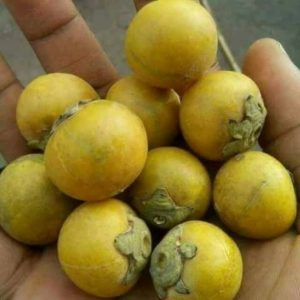
gaab-fruit (photo: Analimbey Sept. 2018)
gaab pl. gaasa, Diospyros mespiliformis, Ebenaceae
African ebony or swamp ebony, date plum; ripe, red fruits (and leaves?) edible,
Margaret fn 40a: a vitamin-rich juice is produced from dried fruits: gaa(b)-siita;
fn 74,280a: Anpan: male gaab (without fruits!) for segrika pot
fn 74,315a: Sandford: roots used for segrika pot
Michael Ankobilla: gaab stick used to handle hot pots; ngam made from green fruit flesh
fn 86,37a: Agalic: gaab-tanggbain in front of Agalic’s house (together with kan-gbega)
fn 88,31b+40: Akanming: ngam-production from hard fruits, together with ninang;
in the dry season they make ga-siita (sweet drink) from fruit
fn 88,199a: Bawa: green, hard fruit is crushed, soaked for 3 days in water, turns red-brown; the liquid is done in zingi (gravel) when the floor of dabiak is renewed; 88,244b: roots for segrika pot in Akanguli-Yeri
fn 88,263a: for the peintiik-shrine pot of Abukuri-Yeri: ga-duok (male gaab tree)
goari, pl. goa, thorn tree, Acacia farnesiana (Appiw); fruits: goari bie,
fn 88.68b: Bawa: thorns on finely structured leaves, decoction of bark on wounds
Akanming: his divination wand was made from goari wood
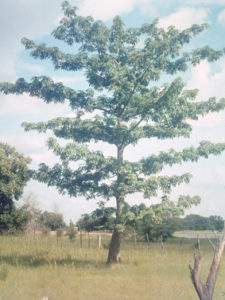
Young kapok tree
gong, pl. gongsa, Ceiba pentandra Bombaceae; kapok, silk cotton tree; leaf with red stems, trunk with thorns on lower part; position of branches almost symmetrical
fn 86,7b: holy tree of the Ewe: cloth band around the trunk
fn 88,26b: medicine in Aluechari’s tibiik: bark of kapok
fn 88,56b: half a kapok fruit in Akanming’s divination bag with the meaning “prosperity”. because kapok is a very big tree.
fn 88,97b: one tree carries millet belts around its trunk to limit its power in case it is a ti-biok (bad tree)
fn 88,263a: for the peintiik pot of Abukuri-Yeri: branch from a tree that penetrates branches of dueb-tree
Irvine 190-3

gula
gula, sing. guli, hollow pieces of grass, species unidentified,
Wiaga-Sinyangsa: worn on waist-strings by babies;
fn 88,199a: Kadema; gula grass near bogluta should give them shades
fn 1988,248: Anisapo needs them for weaving a ngabik (fish-trap)
fn 1988,286b: Ajuik-Yeri and Akanming Yeri: weft threads of the busik basket
gum nang, water-lily, Nymphea lotus
fruit: gumi, poppy-like seeds from the middle of the water-lily buds are eaten
fn 88,217b: Akai: roots of the gumi plant: part of his diviner’s-medicine

gung (water lettuce)
gung, water lettuce, Pistia stratiotes (water plant)
fn 88,64b: Akanming acquires theses aquatic plants in Wiaga-Guuta. He wants to use them for the pot of his crocodile (ngauk) jadok, since crocodiles like to stay among these plants
fn 88,70a: Akanming places gung leaves in his jadok pot and plants some in his pond.
fn 88,285a: in a charred form: divination medicine at Goldem jadok-gobika.
gbarik, sp. tree
Danlardy: medicine against nuoong domka (scorpion bite)
kambongka-mumka-tuenga, spec. type of grass;
Michael Abaala: charred grass for treating bone-fractures
kamperuk or kampelung, pl. kampelungta; Combretum hypopilinum; kaffir butter shrub
fn 88,283b: used for ngam (as a cooked decoction or as a cold extract)
kampodiak, pl. (rare) kampodaasa
Michael Abaala: For koluk pein leng (koluk = testicle, pein = arrow?, leng: calabash bottle?), elephantiasis of the testicles: medicine made of the roots of pukong and kampodiak is used.
kanchain (= kancheli?) shrub, succulent? euphorbia-like
fn 88,57: medicine; leaves have stored sap; leaves are soaked in water for a while, water is poured on thatched roofs in which miadi-termites live
kang-gbegi, kan(g)gbegli or kan(g)gbegluk, pl. kan-gbega
Balanites aegyptiaca, desert date, soap berry tree
very long thorns used for hat weaving; yellow, edible fruit: na-mogli, pl. na-mogla tastes bitter-sourish, thick seed with 1-2 mm flesh
Kröger 1992: its bark, young twigs and roots are used for making fish-poison
fn 86,37b: tanggbain in front of Agalic’s house, together with gaasa 88,63b: Anamogsi produces kang-gbegi medicine, 10 cm long branch pieces, yellow wood; tiim pot at Anyenangdus bogluk. Navrongo people buy 2 bundles for 2 chickens. Previously used bundles are lying on Aluechari’s bogluk; medicine applied when someone can no longer eat and drink: oesophageal closure? pieces of wood charred in ngoadi, vapours inhaled; also: soaked in water for one night and water drunk
88,84b: fruit eaten against stomach pain
Irvine 1961, 208-10
kankpiiling, shrub
fn 1973,153a: roots for segrika pot
kantilak, plant approx. 1/2 m high, small umbels
fn 88,267b: Bawa: if you cut its stems, glue (sim) comes out; glue closes small wounds, which heal quickly.

kantimiiri
kantimiiri, pl. kantimiira seed of an unidentified tree
fn 88,217b: Akai: bought seeds for his divination medicine on the market.
fn 88,227b+275a: Akanming and I bought kantimiiri roots for the Goldem jadok-gobika at Fumbisi market.
kanuesing, kanuising, sp. tree
Kröger 1992: Roots are pounded and mixed with other ingredients as a remedy for piak (onchocerchosis, “oncho”, associated with fever).
katuak, pl. (rare) katuaasa, filtrate from millet ash (see also sarik)
fn 94,65b Akannue: boiled filter liquid (katuak) and applies it to light-coloured skin areas (solimbaata; ringworm?)
Kröger 1992: food with much kaam (residue of katuak) is a remedy against poi-yogsik (diarrhoea, usually with mucus), dysentery, abdominal discomfort (often connected with loss of appetite and vomiting)
kawali, pl. kawala, Annona senegalensis? medium sized tree, edible fruit, syn. waaung-soluk;
fn 1974,280a: roots used as medicine for the segrika-ritual
kinkaning
Michael Abaala: biisim tiim: medicine for the stimulation of human breast milk; is made from the bark of a kinkaning tree
kingkang pl. kingkangsa, Ficus gnaphalocarpa, fig-tree
hard fruit: kingkani, ripe fruit: mook
bark: medicine against milk deficiency of women who have recently given birth
88,68b: Bawa: ripe figs eaten raw, green ones are crushed in a mortar for soup ingredients
88,227a: Akanmings son Ajacke collects roots from kinkang tree at a riverbed as a medicine for his father’s divination bag
Irvine 1961, 429-45
kingkang-piruk /kinkan-peeruk, pl. kingkang-peruta; lives as a parasite on trees
fn 88,212b: Bawa and Danlardy: pobsika-tiim for drawing black crosses after the pobsika-ritual; Anamogsi calls the plant: kuruk
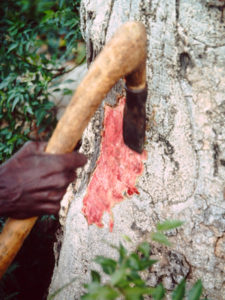
Peeling the bark of a kok tree
kok, pl. koksa, dial. kobik, dry zone mahogany, Khaya senegalensis
bitter fruits not eaten
Margaret 11b: when the navel of a new-born child does not heal, root extracts of kok are used; tastes like magnesium sulphate, chalk
Margaret 26b: at birth a bitter medicine from bark is used for a good digestion (?)
fn 88,61b: Adalenbeka Akanming brushes her foot with red musiri fibres (from kok)
fn 88,82b: from the bark musiri medicine (red cake, pl. musa) is made after drying grinding and soaking; used against boils and swollen feet
fn 88,186a: diviner Awentok (Kpandem): calabash with light vegetable ball: medicine from the pounded bark of kok: against bulges
fn 88,204b: musa is made from the bark of kok, kpasagi, goabiak-mung tree and of the bark of a tree whose other half is dead
fn 88,281b: Vitus and Anurka sprinkle a light brown powder on their pito: it is musiri against stomach pain and hernia
Michael Abaala: biak poi domka, lit. “dog’s stomach ache”, colic pain (of humans) during peristalsis; treatment with the roots of pukong and the bark of kok
Kröger 1992: from its bark, fruit and roots the Bulsa make a medicine against stomach ache
Irvine 1961, 520-4
kon-dem diruk, sp. plant
Akannue:, roots used for making a medicine against ear-pain
kok-namuning (cf. kok, ghost or tree sp.; namuning horn-trumpet), pl. kok-namunsa
sp. shrub in the bush
Kröger 1992: bark and roots are used for baby-medicine; drinking or bathing after an accident
kosukbogi, tree?
fn 88,264a: Inf. via Stefan Völker: medicinal plant: bark boiled in water and its decoction drunk against coughing
kukpaligalik (syn. popogalik), sp. plant (herb)
Dict.: used as stomach-medicine
kurikpaarik or krukpaarik (cf. kikiruk n.), pl. kurikpaarisa or krukpaarisa
(1. malevolent, invisible imp or hobgoblin)
2. magical medicine used in hunting wild guinea fowls; made from burnt herbs by specialists; may be rubbed on the cudgels which are thrown at guinea fowls; medicine also enables hunter to see guinea fowls
kuruk (kruk), parasitic plant on trees (tendril?)
fn 88,137b: Anamogsi: charred kuruk for drawing black crosses after the pobsika ritual
fn 88,304b: Danlardy: grows on cham and kinkanpeeruk trees; from its red pods and seeds glue for catching birds is produced: pods laid in water and crushed, all solid ingredients removed
kususoγluk or kosuk tibiik (kosuk = cough), medicinal plant, tree?
Inf. via Stefan Völker: If one coughs during sexual intercourse; its roots are collected and charred at night: the tiim-nyono comes approx. 3 o’clock in the morning and walks around the house three times, enters the couple’s sleeping place, mixes the charred medicine with water and sprinkles it on the couple three times; he is given one chicken before the ritual and two more after it; he sacrifices one of them to his ancestors; the couple bathes in the root extract and water; a goat is slaughtered, whose blood and innards are cooked and eaten; one leg for the house, the rest for the tiim-nyono
kpaleng, very small and thorny plant
Michael Abaala: used for treating nerisa (boil with pus or hard boil)
kpalung biung (lit. excrement of a hawk),
Michael Abaala: sp. grass, decoction is medicine against wusum sinsam (lit. urine of a horse, hepatites, jaundice)
kpaluok, kpalok, pl. kpaloaata, Hypris spicigifera, mint-like herb; when it is dry, small thorns form on stems
fn 88,1a: Danlardy: used to drive away mosquitoes
Kröger 1992: used for expelling mosquitoes and flies
kpa(a)mviak, kpaam-viok, pl. kpaam-vaata, small herb with rough leaves? Crossopterix febrifuga?
Michael Abaala: tree, from its leaves they prepare a medicine against nor-woruk (chronic ulcer)
Kröger 1992: used as a kind of perfume for bathing water
kpaandinderuk, pl. kpaandinderisa plant, herb, Borreria filofolia?
Kröger 1992: used as medicine agains ear-pain
kpanleng, pl. kpanlengsa, thorny plant
Kröger 1992: charred parts are used as a medicine against boils
kpasagi, pl. kpasaga, Pseudocedrala kotschyi, dry zone cedar
other info: Paradanielli oliveri?
fn 88,204: from the bark of this tree, mixed with other barks, they prepare musiri-medicine
Dict.: roots used as a medicine for stomach ache
Irvine 1961, 527-8
kpasiuk, sp. herb
Michael Abaala: medicine against eye-diseases
kpikpali-galiik, pl. kpkipali-galisa
fn 88,264a: Inf. via Stefan Völker: medicinal plant; from its boiled roots a medicine against abdominal pain is prepared. The liquid is drunk with pepper. As it is very bitter, the patient can drink only very little.
Kröger 1992: from its bark medicine against blood in the faeces, esp. of babies, is made
kpinkpami-bitafiik, pl. kpinkpami-bitafiisa, lit. anus of the kpinkpami bird, kind of grass?
Kröger 1992: medicine for stomach ache
kpoak (= kpuok?), sp. tree
Michael Abaala: roots against poi yogsuk (see above)
kpok
fn 88,264a: medicinal plant
Inf. via Stefan Völker: kpok-nang, branches boiled; against slimy stool;
kpuok, medicinal plant
Inf. via Stefan Völker: bark cooked with vegetables against snake bites, put on wounds over the course of one month
lirung, pl. lirunta, plant
Kröger 1992: specific herbal medicine of magical character; can make sb. invisible
mangkarik, pl. mangkarisa, type of early guinea corn, sorghum, looks like za-monta
Kröger 1992: mangkarik gilini, variety of mangkarik, exclusively grown as a medicine plant against giddiness
miisung, pl. miisinta, sp. grass (Cenchrus cilisaris), buffel-grass or African foxtail grass; syn. Pennisetum ciliare
Kröger 1992: sp. grass, decoction is used as a medicine for small children
mimiri, pl. mimie, Ximenia americana, wild olive or mountain plum, edible fruit
fn 88,283b: used for ngam (cooked or uncooked)
Kröger 1992: mimeri-teng-nang: root of the tree used as medicine against stomach ache (poi-tiim)
Irvine 1961, 472-4
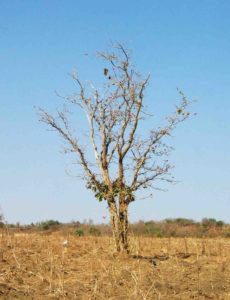
mumulik-tree
mumulik, pl. mumulisa, Erythrina senegalensis, coral flowers,
small tree with bright red flowers
fn 88,185b: bark used for a decoction by women who have recently given birth to increase their milk production
fn 88,263a: branches for the peintiik pot of Abukuri-Yeri
naab-pogluk, pogluk, tree with large leaves
if you pluck a leaf, “milk” comes out, this milk is used for treating ringworm
naayogsum, pl. naayogsunta, Ricinus communis, castor oil plant
fruits smaller than those of tog-tiib, otherwise similar, star-shaped leaves
fruit heaped at the tips of the branches; fruit prickly, smaller than chestnut, flowers very small, immature seeds yellowish or white white, ripe: grey, reddish speckled,
fn 88,199a: seeds are grated and put into soup: against abdominal pain
Kröger 1992: grown in front of some compounds as a medicine plant; for treating constipation, gum bleeding; also used for tanning leather
nabaaning, pl. nabaanisa, sp. bush plant, roots are eaten raw by shepherds
Kröger 1992: medicine for malaria
nangbangzuri, (nanggbang, pigeon, nangzuri= caterpillar), sp. plant, herb
Kröger 1992: medicine against solimbaata (ligth spots on the skin)
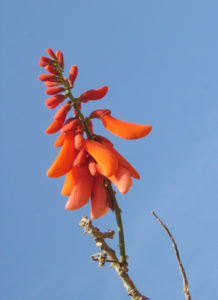
mumulik blossom
ninang pl. ninangsa, Sclerocarya birrea,
fn 88,31b: ngam production together with hard gaab fruits
fn 88, 204: Ayomo: reddish wood, together with zeglik used for ngam
fn 88,213 (23.2.89): Atinang-Yeri: one big chari with zeglik-ngam and one chari with ninang-ngam
fn 88,283b: ngam (cooked or uncooked)
Irvine 1961, 563f
nindaala, plant with black seeds,
medicine against cataract
ngaarib, ngarim, pl. ngaarisa, Vitex cienkowskii,
syn. Vitex doniana “blackberry” tree,
fn 1974,260b: circumcision: roll of ngara vaata put on the wound for one week
ngmanviak-soblik, pl. ngmanviak-soblisa, Moringa oleifera,?? horse radish tree?? (mostly in the bush)
yellow flowers in January, long thin fruits, leaves eaten
fn 88,203b: Bawa: seeds of ripe fruits are used for tongka-bie game (i.e. they are different from the seeds depicted below)
Kröger 1992: leaves used for soup
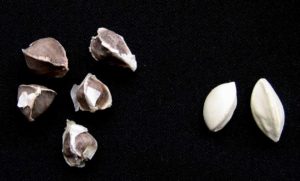
Moringa seeds (as traded in Europe)
Note: Moringa oleifera: In recent times the cultivation of the Moringa oleifera tree has been propagated by development projects. “It is cultivated for its young seed pods and leaves used as vegetables and for traditional herbal medicine… Moringa seed cake, obtained as a byproduct of pressing seeds to obtain oil, is used to filter water… to produce potable water for animal or human consumption. Moringa seeds… absorb and neutralize colloidal charges in turbid water, causing the colloidal particles to clump together, making the suspended particles easier to remove as sludge by either settling or filtration… (https//en.wikipedia.org/wiki/Moringa_oleifera). It could not be clarified how this introduced Moringa-tree-plant is related to the local tree ngmanviak-soblik, which is also called Moringa by some informants. Their seeds are, however, completely different.
ngmanyak, pl. ngmanyaksa, sp. grass
Kröger 1992: decoct used as a medicine for small children
ngmeeung, pl. ngmeeunta, Dendrocalamus deeralus; bamboo, bamboo-stalk
fn 74,319b: bamboo leaf tea: drunk cold, against blood in urine
palik, sp. tree,
Michael Abaala: roots: medicine against chipiirik (hernia) and snakebite,
pasiuk (pasuk?), herb with black fruit seeds
fn 88,166b:, a tuft is kept in some rooms: the black grains are put into the eye when there is a foreign particle, “to clean eyes”.
piak, pl. paasa, main meaning: oncho
fn 86,28b: root concoction against thick testicles
Kröger 1992: pounded roots are mixed with other ingredients as a remedy for oncho
piok
fn 86,8b: from its roots they obtain an antidote against arrow poison
piuk-sunsumi, pl. piuk-sunsuma, Gardenia aqualla or Gardenia jovis-tonantis? “wolf’s nut”
fruits not edible
fn 88,44b: thick, egg-shaped fruit in Akanming’s divination bag means pregnancy
fn 88,199: Bawa: not identical with sunsuma, fruit is hung around the neck of newborn babies for 3-4 days until one week after birth
Danlardy: unripe fruit is hard: inedible; if ripe: foamy; one can eat only a little of it, otherwise it causes flatulence
Irvine 1961, 673-7
pogi, pl. poga, Terminalia avicennioides Combretaceae – similar to shea-tree, leaves edible
Inf. via Stefan Völker: when sb. coughs during sexual intercourse, roots of the pogi are soaked in water and given to the couple
fn 88,283: bark for ngam (cooked or uncooked)
fn 88,263a: leaves for the peintiik pot of Abukuri-Yeri
Irvine 1961, 129-36
pogluk pl. pogluta, Calotropis procera, Sodom apple, small tree or shrub (Appiw)
Danlardy: tree introduced by Europeans, there are many at the Wiaga mission station, children play ball with the green fruit filled with air.
The fruit (biri) is cooked until water turns green, decoction is drunk for 3-4 days against bloody urine (sinsambulik)
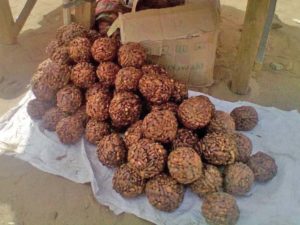
pusik-balls (photo Evans Atuick)
pokong (pukong, poikong), pl. pokongta; edible red fruit,
fn 88,263a: for the peintiik pot of Abukuri-Yeri, together with cham
fn 88,264a: Inf. via Stefan Völker: medicinal plant: branches are soaked in cold water; against spots the liquid is rubbed into the skin and is drunk
Michael Abaala: roots of pukong and bark of kok: medicine against biak poi domka, lit. “dog’s stomach ache”, colic pain (of humans) during peristalsis
Michael Abaala: koluk pein leng (koluk = testicle, pein = arrow?, leng: calabash bottle?), elephantiasis of the testicles; medicine: roots of pukong and kampodiak
pokong nang (nang, root), common medicine for stomach pain, sold on the market,
often mixed with musiri-medicine
popogalik, plant (tree),
Michael Abaala: roots used for a medicine against poi-giruk (constipation)
poosidi, pl. poosa, small foliage bush-plant; Compositae
fn 1973,234: in the dry season rare; in the rainy season it grows in bush valleys; soft, slightly hairy leaves and stems; height: 10-20 cm, thin tap root
fn 1974.260a: circumcision medicine: leaves crushed and mixed with cold water, applied to wound for approx. 3 weeks until wound becomes small
Kröger 1992: put on sores to accelerate the healing process

pusik
pusik, pl. pusisa, Tamarindus indica; tamarind tree, sour fruits
Margaret fn 29a +40a: no use for leaves; the seeds and fruit flesh, formed into balls, can be bought on the market (without skin); they are boiled in water which then tastes like lemon water (vitamin C): it is drunk in case of diseases; it is prescribed by traditional healers; pressed through a sieve it can be added to porridge; gives T.Z. a slightly sour taste
fn 86,8b: from its roots an antidote against arrow poison is obtained
Irvine 1961, 318-20
puusik
fn 1974,224b: circumcision wound treated with puseri, a medicine obtained from puusik, it burns like pepper;
samanda, medicinal plant
fn 88,264a: Inf. via Stefan Völker: samanda-viuk: against loss of appetite; leaves cooked and eaten with T.Z.
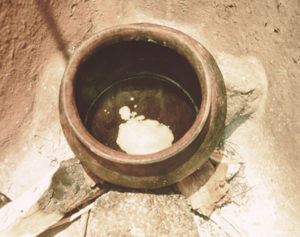
kaam (residue)
sarik pl. (rare) sarisa, mixture of powdered tobacco and kaam
fn 88,13a+b: production in Akanming Yeri: ; kaam produced by evaporation of (liquid) katuak over a fire; dry pounded tobacco leaves, kaam and shea oil are mixed to become sarik. Akanming places a cup of sarik in his own room and everyone can take it, also his wives Adalenbeka and Awiilie.
Danlardy: one gets “drunk” (dizzy) from it, Akanming takes very much, especially before divinatory sessions
Michael Abaala: bleeding wound (ziim weka) is rubbed with sarik (sarik nye fatinka)
Kröger 1992: medicine for small boils at one’s gums (boils: nyin-moarini, pl. nyin-moarima)
sigirik, pl. sigirisa, Acacia nilotica? Acacia seyal? shrub or small thorn tree, wattle gum-tree,
Egyptian spinosa,about 2-cm-long thorns, small leaves double pinnate
pods for tanning and for dark dye; the potter Asiukpienlie uses them for dark patterns on her pots,
fn 88,72b: Akanming collects bark on Pung Muning: he wants to dye some cords black, watery liquid with the bark is reddish, the next day the cord is put into black mud; sigirik fruits would be better than bark, but they don’t grow at the moment,
fn 88,117b: small pots are completely dipped into a sigirik decoction after firing, other pots are painted
fn 88,238b: Atinang Yeri: old woman boils sigirik bark in water; they are used for a child who has troubles with its leg.
Irvine 1961, 320-30
sinsankun, pl. sinsankuna. plant with hollow stalks
Kröger 1992: a special “medicine” for babies, consisting of parts of the plant on a string: medicine against convulsions, blood in urine etc.
solinkperi or solenkperi, sp. tree
Michael Abaala: from its roots a medicine against naworuk (ulcers) is made.
song or yüong, pl. yongta
fn 1986,23b: boiled in water: duinsa tiim, repellent against mosquitoes
ti-niensiri, pl. ti-niensa, big plant
Kröger 1992: roots are used for birth-medicine (biam-tiim)
ti-nyum, sp. tree
fn 88,212b: very rare, only in distant bush, from its roots a twin-medicine is made.
Michael Abaala and Akannue: ti-nyum, very rare, roots: medicine for twins
Dict.: roots are used for medicine, e.g. after a foot birth (tulimbaziik) or after the birth of a kikiruk (“fairy”)
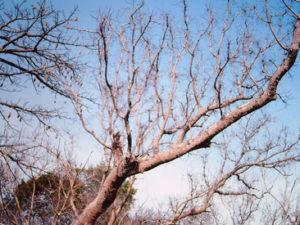
Titibi gami
titibi, pl. titiba; Combretum glutinosum, Combretum ghasalense? shrub
fn 1973,243: most common shrub, not higher than 1m, very hard leaves: olive green; leaves mostly crimped
fn 74,328a: titibi leaves in rolls on circumcision wound
fn 88, 253b: Ayomo: decoction of titibe-leaves are put in the bath water of newborn baby
fn 88,197b: Inf. via R. Schott: before a funeral the mat bearers breathe in the smoke from charred titibi
fn 88,286a: for poi-nyatika (pregnancy ritual) of Achiiklie; titibi and cham leaves float on the water in a black calabash
Michael Abaala: titibi branches are stuffed between pots during firing
Irvine 1961, 113-24
titibi-gami (titibi: see above, gami = leper) variety of titibi or: crippled titibi?
Danlardy Leander: titibi leaves are always crimped and with ‘knobs’
fn 88,263a: roots are in the peintiik pot of Abukuri-Yeri
Kröger 1992: roots are used as a medicine for dysenthery
titibi-nang-magli, pl. titibi-nang-magla, Combretum sp.; branches of titibi tree interwoven
fn 86,24b: wood for firing pots
fn 88,263a: root of titibi namelung in the peintiik pot of Abukuri-Yeri
togbogi, pl. togboga, plant, grass? used for making war-helmets
Michael Abaala: medicine for treating ulcers (naworuk)
Danlardy Leander: roots are cooked for treating stomach pains
togi-tiim (togi = termite), Datura sp.
fn 88,118b: some shrubs in front of Ayomo’s house; togi-tiim: against termites in houses and barns
tolum, plant, flower of this plant?
fn 73,247b: Norbert Achaw: shepherds apply the sap of the tolum flower on their upper arms; the spot swells the next morning and a scar remains
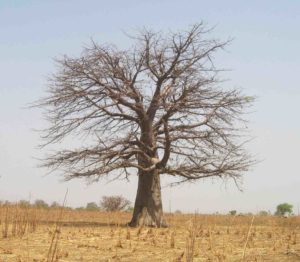
baobab (tuik)
tuik, pl. tuisa, Adansonia digitata; baobab tree,
wood is completely unsuitable for carving, building, firewood etc. as it is too soft; fallen baobab trees usually remain lying and are not exploited; only the fruits are useful
Togo 7b: holy tree of the Ewe, they often wear a cloth belt
Margaret 40a: seeds (chikpegli) are removed from the inner marrow of the fruit and pulverized in a mortar; powder stored in clay pot or calabash; dissolved in water or milk it makes a drink with sugar; oil is produced from the seeds in South Ghana but not in Bulsaland.
fn 78,2b: Leander: whoever picks some baobab fruits does not need to ask the owner, although for larger quantities he has to.
fn 78,8b: Kalijiisa: baboab as tanggbain: Angmara (Yongsa)
fn 88,15b: Danlardy Leander: trees on fields belong to field owners, friends cannot take more than one fruit for consumption (without asking); trees in the bush free for all; fruits harvested mainly because of the seeds, which are opened and placed in water, pulp removed (also sucking possible), or: pounded in a mortar, the white powder can only be stored for a few days, eaten raw; seeds with skin can be stored for a long time in a calabash or clay pot; seeds without skins are pounded and used for soups.
fn 88,71b: Anamang Tuik: tanggbain: baobab and rocks, receives sacrifices by Guuta
fn 88,79a: Chiok: 30 baobab kernels in ginggaung-drum
fn 88,82b: fibres made from roots
fn 88,97b: in Badomsa: a baobab wears a belt of millet stalks; this is a prophylactic measure (it might be a bad tree, ti-biok)
fn 88,208b: Atiim-guuk: baobab grew out of bui (grain store); it is considered holy, no branches cut off
fn 88,216b: Ayomo’s house: seeds (tu-kpegla) crushed in a small mortar, then sieved through a fly wire into a calabash, which is in the mortar, grey-beige flour, used for soups, shells thrown away
fn 88,250b: Anisapo: fruit stones for sinyaara rattle: tuik-piila
fn 88,253a: baobab fruit shells burnt in a pottery fire
fn 88,263a: for the peintiik pot of Abukuri-Yeri: baobab bowl floats on the liquid (for drinking?)
fn 88,266b: Akperibasi: very strong fibre from roots, difficult to produce;
fn 88,309a Danlardy Leander: never planted near a farmstead
Irvine 1961, 185-8
tuik songta (no relation to tuik, ‘mortar’ and ‘baobab’), small plant of the bush
Michael Abaala: used as a medicine against kuusiri (breast-pain),
Danlardy Leander and Ayomo Ayuali: roots dug and boiled
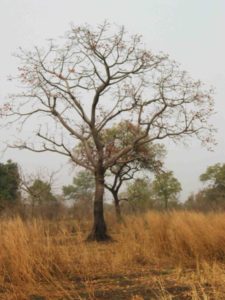
vuoom
viak-sobluk, oat-like grass type
fn 88,67b: when sb. has bloody urine, one cuts off leaves and fruits and soaks them in water, which becomes yellow; extract is drunk hot daily
vuoom (voong), pl. vuoomsa; Bombax buonopozense?
Bombax costatum? red-flowered silk-cotton tree
fn 88,124a: in Ayomo’s house red flowers are cut up and dried, fruit: voom-ligsa, like small red apples, cut into slices and dried, ingredient for soup
fn 88,129b: Abasitemi Yeri: women dry and cut vuoom fruits (vuoom-ligsa)
fn 88, 150: Chiok carver: its wood is very soft, but is used for carving
fn 88,263a: for the peintiik pot of Abukuri-Yeri: 4 bark pieces of the voong tree of the female Ayiisieng tanggbain
fn 88,297b: bark of the red-flowering kapok tree (voong): voolung: cork-like; as a float (bumbobroa) on the jum-piema (fish hook)
for the disease biak segi (dog’s hiccup), in which the fingers cannot be bent, 2-3 pieces of voolung are tied around the wrist by a thread
Irvine 1961, 188-90

vuoom blossom
waaung-diok
fn 86,8b: from roots: antidote against arrow poison
waaung-soluk, pl. waaung-sola; syn. kawala, Annona senegalensis
wild custard apple; fruit: biamoong (biamuook): berries eaten fn fn 1974,280a: also called kawala; roots for segrika pot
fn 88.65a: waaung-soluk: Ayomo’s jadok-shrine
weerik nindaaruk (weerik = yuerik leopard? nindaaruk = ??), sp. tree
Michael Abaala: roots are used for treating boils
wusum wuuk, grass sp., Brachiaria distichophylla
against wusum sinsam, lit. ‘urine of a horse’,
decoction of wusum wuuk for treatment of hepatitis
yauk-nyiok, pl. yauk-nyueta, lit. ‘crocodile’s intestine’, climbing plant
fn 88,274b: Ayomo puts bundles into a bimibili-pot with water, standing over a fire; “Ba tugli biika” (for baby), he points to his stomach (with stomach pain?)
fn 88,227b: Akanming and I get it in the forestry reservation for a medicine used at the jadok-gobika in Goldem, plant has “wrapped” a small kangoatik tree; yauk-nuyok is also good for abdominal pain
fn 88,285a: diviner’s medicine at Goldem jadok-gobika, charred medicine, may be eaten only by diviners, but Akanming has allowed his son Ajacke to use it; when Akanming hit the head of the novice, he had yauk-nyiok in his hand.
Kröger 1992: used as medicine for stomach ache; sold on the market

yiilo
yiilo
88,275a: divination medicine at Goldem jadok-gobika
yiri-yiili, small tree
Michael Abaala: medicine against chest pain
zeglik, pl. zegliksa, zegleksa sp. thorn tree (Acacia sp.) yellow wood
Kröger 1992: bark used for ngam, roots for medicine against sinsambulik (bloody urine)
zu-kuusa, small shrub, ca. 1,50 m tall, trumpet-shaped flowers, tips violet, fruit with spines
fn 88,199a: Akperibasi: if sb. dies and his wife marries before the first funeral and she sees sb. sick of headache, she ties it to his hand as a remedy
Kröger 1992: fruit worn at the patient’s wrist: medicine against headache
Some Statistics
The list above presents remedies against nearly all diseases that might appear in a tropical country.
The list of diseases and the number of possible remedies (below) shows that more than one medicine is available for some frequently occurring diseases (e.g. stomach ache: 10; abdominal pains: 6). This diversity can be explained in part by the fact that the medicines refer to different manifestations of the diseases, and in part by the simple tradition of a house or a healer.
a) medicines
abdominal pain: 6 types of medicine
appetite (loss of): 1
Bilharzia: 1
bleeding from gums: 1
bloody stool: 1
bloody urine (sinsambulik): 6
boils and swollen feet: 3
boils (small boils on gums): 1
bone fractures: 3
breast-milk (stimulation of): 3
breast/chest pain (kuusiri): 3
cataract: 1
colic during peristalsis: 2
constipation (poi giruk): 3
cough: 39
diarrhoea (poi yogsik): 4
digestion (problems): 1
dysentery: 3
ear-pain: 2
elephantiasis of testicles: 3
eyes-disease: 1
eyes: foreign particle in eye: 1
fever: 2
giddiness: 1
headache: 2
hepatitis / jaundice: 2
hernia (chipiirik): 2
leg-troubles: 2
malaria: 2
measles: 1
mumps (?), swollen cheeks): 1
oncho (piak): 1
ringworm (koosuk): 1 (see also ‘spots”)
scorpion bite: 1
slimy stool: 1
snake-bite: 2
spots (light spots on skin, solimbaata, see also ringworm): 3
stiff fingers (biak segi): 1
stomach ache: 10
swallowing food not possible: 1
ulcer (chronic, nor-woruk): 3
vitamines (deficiency of): 1
wounds (applied on): 8
b) magical and ritual means
amulet: 2
birth medicine (part of): 3
cough during sex: 2
diviner’s medicine: 6
magic hunting medicine: 2
peintiik (shrine): 8
pobsika-tiim: 2
poi nyaatika: 2
segrika pot: 6
c) other functions of plants and plant extracts
arrow poison (antidote): 3
fish poison: 1
ngam (liquid for making mud walls resistant against rain): 5
repellent (against mosquitoes): 4
termite poison: 2
REFERENCES
Abbiw, Daniel K. (1990): Useful Plants of Ghana. West African uses of wild and cultivated plants. Intermediate Technology Publications and The Royal Botanic Gardens, Kew.
Irvine, F.R. (1961): Woody Plants of Ghana. With Special Reference to their Uses. London: Oxford University Press.
Kröger, Franz (1992): Buli-English Dictionary. With an Introduction into Buli Grammar and an Index English-Buli. Münster and Hamburg: Lit Verlag
- Contents of BULUK 12
- Editorial
- Events
- Who on Earth is interested in the Bulsa?
- Discussions in the Facebook Group “BULUK KANIAK”
- New Published and Unpublished Studies on Bulsa Culture
- The Sights, Sounds and Glitter of Feok 2018
- Report on BHCS Exhibition of Bulsa Material Objects at Feok 2018 in Sandema
- Bulsa Pomp and Pageantry
- John A. Agandin: Two Poems
- The Medical System of the Bulsa
- List of Plants for Medicine and Other Purposes
- Dental Health – the next lifestyle disease?
- Free surgical procedures by Dr. Benjamin Akinkang’s Team of Hope
- Ambulance not on the Road: A Disgrace to Health Care for Buluk
- Management of Perceived Malaria Infections in Children among Bulsa Mothers